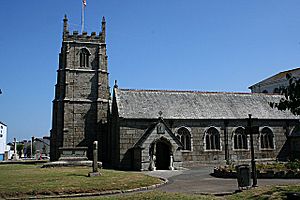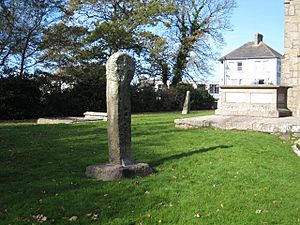Camborne facts for kids
Quick facts for kids Camborne
|
|
|---|---|
 Commercial Square, Camborne Town Centre |
|
 Coat of arms |
|
| Lua error in Module:Location_map at line 530: Unable to find the specified location map definition: "Module:Location map/data/Cornwall (mainland)" does not exist. | |
| Population | 21,600 (2013) |
| OS grid reference | SW645400 |
| Civil parish |
|
| Unitary authority | |
| Ceremonial county | |
| Region | |
| Country | England |
| Sovereign state | United Kingdom |
| Post town | CAMBORNE |
| Postcode district | TR14 |
| Dialling code | 01209 |
| Police | Devon and Cornwall |
| Fire | Cornwall |
| Ambulance | South Western |
| EU Parliament | South West England |
| UK Parliament |
|
| Website | www.camborne-tc.gov.uk |
Camborne (in Cornish: Kammbronn, meaning "crooked hill") is a town located in Cornwall, England. In 2011, about 20,845 people lived there. The northern part of the town's area includes a section of the beautiful South West Coast Path, along with places like Hell's Mouth and Deadman's Cove.
Camborne was once one of the richest tin mining areas in the world. It was also home to the famous Camborne School of Mines.
Contents
Exploring Camborne's Location and Landscape
Camborne is in the western part of Cornwall's biggest urban and industrial area. The town of Redruth is only about 3 miles (5 km) to the east. Camborne is the main church center for a large civil parish and has its own town council.
The Camborne-Redruth area sits on the northern side of the Carn Brea/Carnmenellis granite uplands. These hills gently slope down towards the sea in the north. The two towns are connected by the A3047 road. This road was built in 1839. Along this road, you'll find villages like Roskear, Tuckingmill, Pool, and Illogan.
Several small streams flow north-south through the area. Their valleys have been deeply cut over hundreds of years by tin streaming and other industrial activities. The Red River valley, for example, crosses the A3047 at Tuckingmill. To the north, the A30 (road) separates the town area from the farmland.
What's the Weather Like in Camborne?
Camborne has an oceanic climate, which is typical for Cornwall. This means the temperatures don't change much throughout the year, even compared to other parts of the UK. Because there isn't a large landmass nearby, warm air from Europe cools down over the sea in summer. In winter, cold air is made milder by the same effect. It rains often all year because of moist air coming from the Gulf Stream.
| Climate data for Camborne, elevation: 87 m or 285 ft (1991–2020 normals), extremes 1973–present | |||||||||||||
|---|---|---|---|---|---|---|---|---|---|---|---|---|---|
| Month | Jan | Feb | Mar | Apr | May | Jun | Jul | Aug | Sep | Oct | Nov | Dec | Year |
| Record high °C (°F) | 15.5 (59.9) |
16.0 (60.8) |
18.5 (65.3) |
22.3 (72.1) |
24.5 (76.1) |
27.7 (81.9) |
30.4 (86.7) |
30.4 (86.7) |
27.1 (80.8) |
23.8 (74.8) |
18.8 (65.8) |
15.3 (59.5) |
30.4 (86.7) |
| Mean maximum °C (°F) | 12.4 (54.3) |
12.1 (53.8) |
14.1 (57.4) |
16.9 (62.4) |
20.1 (68.2) |
22.4 (72.3) |
23.5 (74.3) |
22.6 (72.7) |
21.5 (70.7) |
18.1 (64.6) |
15.1 (59.2) |
12.9 (55.2) |
24.7 (76.5) |
| Mean daily maximum °C (°F) | 9.2 (48.6) |
9.2 (48.6) |
10.2 (50.4) |
12.1 (53.8) |
14.5 (58.1) |
16.9 (62.4) |
18.7 (65.7) |
19.0 (66.2) |
17.5 (63.5) |
14.6 (58.3) |
11.8 (53.2) |
9.9 (49.8) |
13.6 (56.5) |
| Daily mean °C (°F) | 7.1 (44.8) |
6.9 (44.4) |
7.8 (46.0) |
9.4 (48.9) |
11.7 (53.1) |
14.1 (57.4) |
16.0 (60.8) |
16.2 (61.2) |
14.8 (58.6) |
12.3 (54.1) |
9.6 (49.3) |
7.8 (46.0) |
11.1 (52.0) |
| Mean daily minimum °C (°F) | 4.9 (40.8) |
4.6 (40.3) |
5.4 (41.7) |
6.6 (43.9) |
8.8 (47.8) |
11.3 (52.3) |
13.2 (55.8) |
13.4 (56.1) |
12.0 (53.6) |
10.0 (50.0) |
7.4 (45.3) |
5.6 (42.1) |
8.6 (47.5) |
| Mean minimum °C (°F) | −0.5 (31.1) |
−0.5 (31.1) |
0.8 (33.4) |
1.9 (35.4) |
4.6 (40.3) |
7.3 (45.1) |
9.4 (48.9) |
9.6 (49.3) |
8.0 (46.4) |
5.2 (41.4) |
2.1 (35.8) |
0.3 (32.5) |
−2.2 (28.0) |
| Record low °C (°F) | −9.4 (15.1) |
−6.3 (20.7) |
−5.2 (22.6) |
−2.3 (27.9) |
0.3 (32.5) |
4.8 (40.6) |
7.0 (44.6) |
7.4 (45.3) |
4.8 (40.6) |
−0.3 (31.5) |
−3.8 (25.2) |
−4.7 (23.5) |
−9.4 (15.1) |
| Average precipitation mm (inches) | 120.6 (4.75) |
94.6 (3.72) |
71.8 (2.83) |
72.8 (2.87) |
61.2 (2.41) |
62.9 (2.48) |
69.0 (2.72) |
78.5 (3.09) |
77.5 (3.05) |
111.2 (4.38) |
129.8 (5.11) |
126.1 (4.96) |
1,075.8 (42.35) |
| Average precipitation days (≥ 1.0 mm) | 16.6 | 13.6 | 12.1 | 11.6 | 9.8 | 9.5 | 9.8 | 11.4 | 11.4 | 15.0 | 17.5 | 17.0 | 155.3 |
| Mean monthly sunshine hours | 61.1 | 84.5 | 125.3 | 187.5 | 216.2 | 214.6 | 198.9 | 187.2 | 159.7 | 111.6 | 70.2 | 55.4 | 1,672.1 |
| Source 1: Met Office | |||||||||||||
| Source 2: KNMI Infoclimat | |||||||||||||
The UK Met Office has an Upper Air Station in Camborne.
Camborne's Rich History
The town of Camborne was first mentioned in 1181. However, in 1931, the ruins of a possible Romano-British villa were found nearby. This shows people lived here much earlier.
There are also old Christian sites, like an inscribed stone from the 10th or 11th centuries. This stone is now in the Church of St Martin and St Meriadoc. It proves that a settlement existed here a long time ago.
By 1708, Camborne was allowed to hold markets and three fairs each year. As industries grew, more people moved to the town. The first chapel was built in 1806, and a local Methodist community grew. In 1823, about 2,000 people lived in Camborne. By 1841, the population was 4,377. More than two-thirds of the working people were in the mining industry.
The town continued to grow. A gasworks opened in 1834, and the Hayle Railway was built between 1834 and 1837. Holmans opened a small factory in 1839. The current Market House was finished in 1866.
Camborne's Mining Past
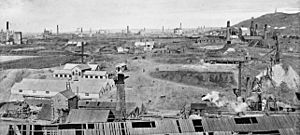
Mining in Camborne started as early as the 1400s. People first dug for tin in small streams and shallow mines. Adit mining, which uses horizontal tunnels, began in the 16th century. Camborne became famous as a major center for Cornish tin and copper mining. Its busiest time was in the late 1700s and early 1800s.
Camborne was just a small village until the mining boom. The area around Camborne and Redruth became known as the "richest square mile in the old world."
As mining started to decline in the 1870s, tensions grew. In October 1873, thousands of miners and townspeople protested against the police. They damaged the Town Hall and the Police Station. The police officers were beaten and scattered. Soldiers from Plymouth had to be called in to stop the unrest. No one was ever convicted for the riots. The entire Camborne police force was found to be at fault and changed.
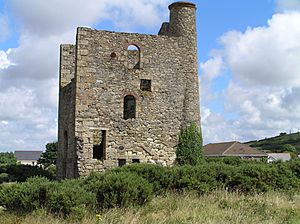
Dolcoath Mine, also known as the 'Queen of Cornish Mines', was once the deepest mine in the world. It reached a depth of 3,500 feet (1,067 meters). It was also one of the oldest mines before it closed in 1921. South Crofty, the last working tin mine in Europe, was also in Camborne. It closed in 1998.
Industries Supporting Mining
Besides the mines, Camborne was home to important related industries. One was the famous foundry of Holman Bros Ltd (CompAir). Holmans was a family business started in 1801. For many years, it was Camborne's largest maker of industrial equipment. They even made the famous Sten submachine gun during the Second World War. The Holman Projector was used by the Royal Navy. At its peak, Holmans had three sites in Camborne and employed about 3,500 people. The Compair Holmans factory in Camborne closed in 2003.
Some tin from South Crofty was bought by a local company. This tin is used to make special tin jewelry, called the South Crofty Collection. Tin from South Crofty was even used to make the bronze medals for the 2012 London Olympics!
Camborne School of Mines
Because metal mining was so important to Cornwall, the Camborne School of Mines (CSM) became the only special school for hard rock mining education in the UK. It was established in 1888. Today, it is part of the University of Exeter. In 2004, it moved to the university's Tremough campus, now called Penryn Campus.
The Story of Steam Locomotion
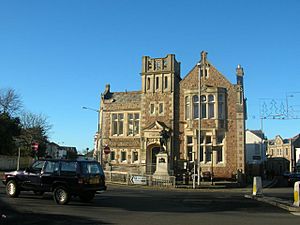
On Christmas Eve in 1801, the Puffing Devil made history. This was a steam-powered road vehicle built by Camborne engineer Richard Trevithick. It traveled up Camborne Hill in Cornwall. It was the world's first self-propelled vehicle that could carry passengers! This event is remembered in a local song:
- Going up Camborne Hill, coming down,
- Going up Camborne Hill, coming down,
- The horses stood still,
- The wheels turn around,
- Going up Camborne Hill, coming down.
The Cornish Language in Camborne
The Cornish language was spoken in the Camborne area until the early 1700s. Records show that everyone west of Truro spoke Cornish in 1644. Nicholas Boson wrote that Cornish was spoken as far east as Redruth and Falmouth around 1700. In 1700, the language expert Edward Lhuyd visited Cornwall to study the language. He came to Camborne and wrote down many details about the area.
One important old Cornish story is Beunans Meriasek, which is about St Meriadoc, the patron saint of Camborne. In the 1800s, people from Camborne were sometimes called Mera-jacks or Merry-geeks.
In the 1900s, some Cornish words and phrases were still used by people in Camborne. These included taw tavas (silent tongue) and allycumpoester (all in order).
While some Cornish was taught in schools in west Cornwall in the 1800s and early 1900s, the first school to really focus on teaching the revived Cornish language was Mount Pleasant House. This school was run by E. G. Retallack Hooper after the Second World War. By 1984, Cornish was being taught in Troon and Camborne primary schools, as well as Camborne secondary school. There was even a Cornish language playgroup. In 2000, Roskear and Weeth schools were teaching Cornish.
In the 2011 United Kingdom census, 30 people in Camborne said Cornish was their main language at home.
How Camborne is Governed
Who Represents Camborne in Parliament?
The Camborne and Redruth area became its own constituency for the 2010 general election. This happened after a review of how Cornwall was represented in Parliament. The number of seats in Cornwall increased from five to six.
This new area mostly took over from the old Falmouth and Camborne seat.
In the 2024 United Kingdom general election, the results for Camborne and Redruth were:
| General election 2024: Camborne and Redruth | |||||
|---|---|---|---|---|---|
| Party | Candidate | Votes | % | ±% | |
| Labour | Perran Moon | 19,360 | 40.5 | +6.3 | |
| Conservative | Connor Donnithorne | 11,554 | 24.2 | -29.1 | |
| Reform UK | Roger Tarrant | 8,952 | 18.7 | +18.7 | |
| Liberal Democrats | Thalia Marrington | 4,113 | 8.6 | +0.1 | |
| Green | Catherine Hayes | 2,840 | 5.9 | +3.1 | |
| Liberal | Paul Holmes | 624 | 1.3 | 0.0 | |
| Socialist Labour | Robert Hawkins | 342 | 0.7 | +0.7 | |
| Majority | 7,806 | 16.3 | +2.3 | ||
| Turnout | 48,007 | 64.6 | -7.1 | ||
| Labour gain from Conservative | Swing | +17.7 | |||
Churches and Their History
Camborne's main church is called St Martin and St Meriadoc’s Church. It is made entirely of granite and dates back to the 15th century. It has older parts too, like a Norman stone found in 2009. The church is a Grade I listed building. St Martin was added to the church's name in the 15th century.
The church has a western tower about 60 feet high with eight bells. The building was renovated in 1861-62. An extra south aisle was added in 1878–79. The church reopened on August 7, 1879.
An inscribed stone found at Chapel Ia, Troon, is now an altar in the church. It dates from the 10th or 11th centuries and shows that people lived there long ago. The churchyard also has several old crosses collected from nearby areas.
Two other chapels existed in the medieval period. One was dedicated to Our Lady and St Anne. Another at Menadarva was a Celtic chapel dedicated to St Derwa.
Getting Around Camborne
The A30 main road now goes around the northern edge of the town. The old A30 road that used to go through the town is now called the A3047.
The Camborne railway station is about half a mile south of the town center. It has a level crossing and a footbridge. Camborne station used to be known for its short platforms. This meant that passengers on trains between London Paddington and Penzance could only get on and off from certain carriages. Because of this, not all trains stopped at Camborne. The platforms have been improved now. Camborne railway station is served by CrossCountry and GWR trains.
For about 25 years, Camborne was one end of Cornwall's only tram service. This tram system opened in November 1902 and ran regularly to Redruth until it closed in September 1927.
Sports in Camborne
Camborne RFC is a famous rugby club in Cornwall, started in 1878. Many players from this club have played for Cornwall. In 1987, Camborne was the highest-ranked Cornish club in the new National leagues.
Camborne is one of the grounds used by the Cornish rugby team. It has hosted many famous international teams, including the New Zealand 'All Blacks' in 1905, 1924, and 1953. Other teams like Australia, South Africa, and the United States have also played here. Since 2006, the Recreation Ground has been shared with the Cornish Pirates rugby team. The ground has been updated with a new stand.
Notable local rugby players include Josh Matavesi, who debuted for Fiji at 18, and his younger brother Sam.
Cornish Wrestling Tradition
Camborne has been a big center for Cornish wrestling for many centuries. Tournaments were held at various places, including the Pendarves Arms Inn, the Unicorn Inn, and the recreation ground. There were also local cups to compete for, like the "Mrs Bramble Cup."
Sam Ham (1880–1946), born near Camborne, was the 1910 middleweight Cornish wrestling champion of South Africa.
Learning in Camborne
A Church of England school was built in College Street in 1844. The next year, a school for 400 boys opened. In 1847, the Basset Road British (Methodist) School opened. A School of Mines started in 1872.
Today, Camborne has many schools for all ages. The main secondary school is Camborne Science and International Academy, which started in 1956. There is also a campus of Cornwall College.
A private girls' school, Redbrook College, was founded in 1877. It became a state grammar school for girls in 1908, called Camborne Grammar School. It later joined with Treswithian School in the 1970s.
Camborne's Twin Towns
Camborne is twinned with two places:
- Santez-Anna-Wened in Brittany, France
- Pachuca, Hidalgo in Mexico
Camborne became twinned with Pachuca in a ceremony in Mexico on July 3, 2008.
The town's name also inspired the name of Camborne, New Zealand. This is a seaside area near Porirua City. Most of its street names are from Cornwall.
Culture and Arts
Music Scene
- Camborne Town Band has been competing in music contests since the late 1800s. They have even performed on BBC Radio.
- Holman Climax Male Voice Choir, based in Camborne, was formed in 1940.
Literature and Film Connections
- Alan M. Kent's 2005 novel Proper job, Charlie Curnow! is set in and around a fictional housing estate on the edge of Camborne.
- Zoie Palmer, an actress, was born in Camborne.
Well-Known People from Camborne
- Annie Carvosso (1861–1932), a social activist and reformer.
See also
 In Spanish: Camborne para niños
In Spanish: Camborne para niños




